Case Study: Mental Health Nursing and Clinical Interventions for Barry
VerifiedAdded on 2021/04/19
|7
|2368
|40
Homework Assignment
AI Summary
This assignment presents a detailed case study in mental health nursing, focusing on a patient named Barry who is experiencing anxiety disorder. The student discusses the key interpersonal skills required for an effective interview with Barry, including active listening and clear communication, recognizing his restlessness and anxiety. The assignment identifies three crucial signs and symptoms indicative of a mental health disorder, specifically generalized anxiety disorder, as exhibited by Barry, including physical symptoms like sleep problems, digestive issues, shortness of breath, and excessive worry. The student then describes two clinical interventions: the stress-vulnerability model and cognitive behavioral therapy (CBT), explaining how these can be implemented to address Barry's condition. Finally, the assignment addresses the information a nurse needs to provide to Barry about the prescribed medication, venlafaxine 75mg, including its purpose, potential side effects, and important precautions regarding its use and interactions with other drugs.
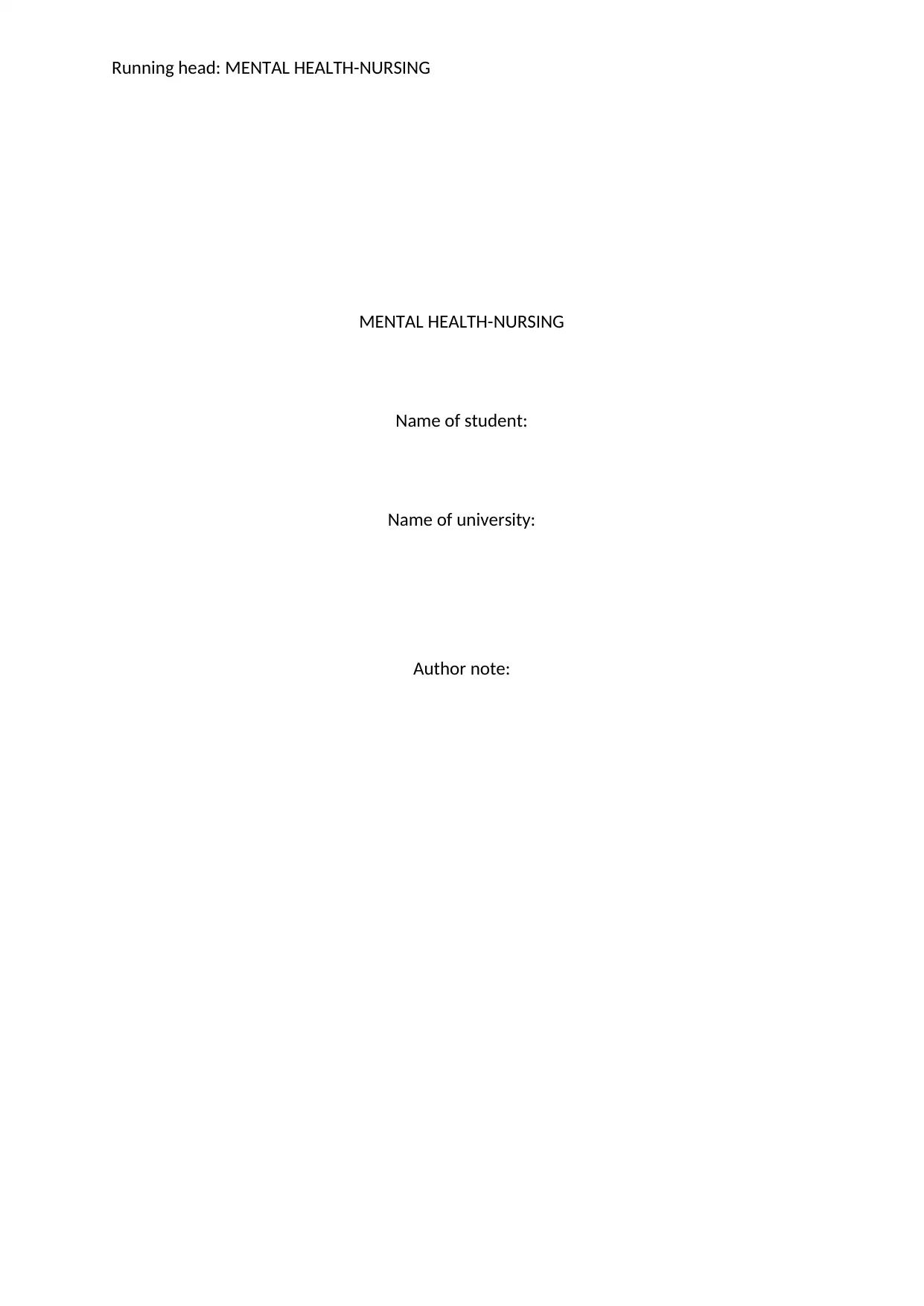
Running head: MENTAL HEALTH-NURSING
MENTAL HEALTH-NURSING
Name of student:
Name of university:
Author note:
MENTAL HEALTH-NURSING
Name of student:
Name of university:
Author note:
Paraphrase This Document
Need a fresh take? Get an instant paraphrase of this document with our AI Paraphraser
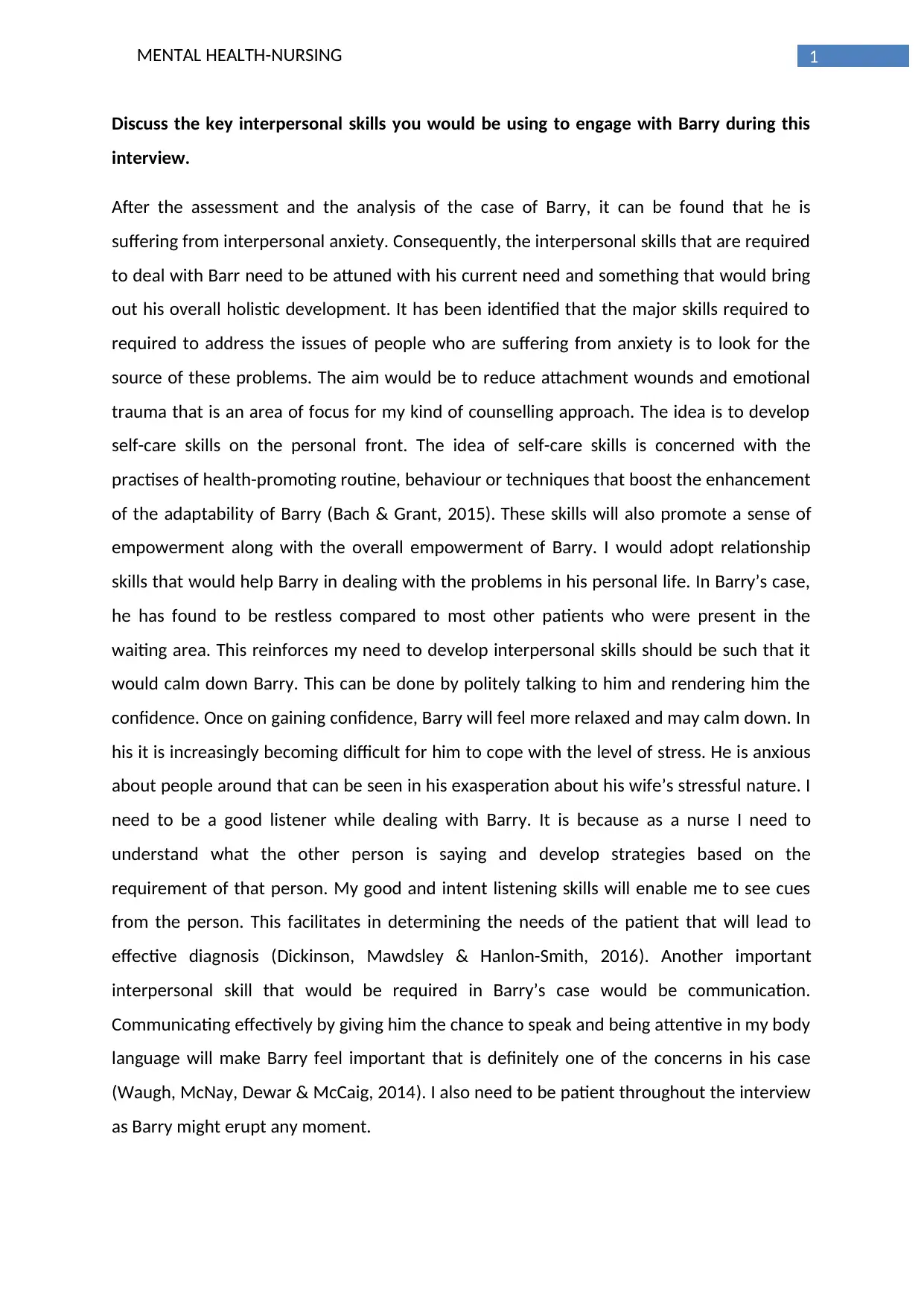
1MENTAL HEALTH-NURSING
Discuss the key interpersonal skills you would be using to engage with Barry during this
interview.
After the assessment and the analysis of the case of Barry, it can be found that he is
suffering from interpersonal anxiety. Consequently, the interpersonal skills that are required
to deal with Barr need to be attuned with his current need and something that would bring
out his overall holistic development. It has been identified that the major skills required to
required to address the issues of people who are suffering from anxiety is to look for the
source of these problems. The aim would be to reduce attachment wounds and emotional
trauma that is an area of focus for my kind of counselling approach. The idea is to develop
self-care skills on the personal front. The idea of self-care skills is concerned with the
practises of health-promoting routine, behaviour or techniques that boost the enhancement
of the adaptability of Barry (Bach & Grant, 2015). These skills will also promote a sense of
empowerment along with the overall empowerment of Barry. I would adopt relationship
skills that would help Barry in dealing with the problems in his personal life. In Barry’s case,
he has found to be restless compared to most other patients who were present in the
waiting area. This reinforces my need to develop interpersonal skills should be such that it
would calm down Barry. This can be done by politely talking to him and rendering him the
confidence. Once on gaining confidence, Barry will feel more relaxed and may calm down. In
his it is increasingly becoming difficult for him to cope with the level of stress. He is anxious
about people around that can be seen in his exasperation about his wife’s stressful nature. I
need to be a good listener while dealing with Barry. It is because as a nurse I need to
understand what the other person is saying and develop strategies based on the
requirement of that person. My good and intent listening skills will enable me to see cues
from the person. This facilitates in determining the needs of the patient that will lead to
effective diagnosis (Dickinson, Mawdsley & Hanlon-Smith, 2016). Another important
interpersonal skill that would be required in Barry’s case would be communication.
Communicating effectively by giving him the chance to speak and being attentive in my body
language will make Barry feel important that is definitely one of the concerns in his case
(Waugh, McNay, Dewar & McCaig, 2014). I also need to be patient throughout the interview
as Barry might erupt any moment.
Discuss the key interpersonal skills you would be using to engage with Barry during this
interview.
After the assessment and the analysis of the case of Barry, it can be found that he is
suffering from interpersonal anxiety. Consequently, the interpersonal skills that are required
to deal with Barr need to be attuned with his current need and something that would bring
out his overall holistic development. It has been identified that the major skills required to
required to address the issues of people who are suffering from anxiety is to look for the
source of these problems. The aim would be to reduce attachment wounds and emotional
trauma that is an area of focus for my kind of counselling approach. The idea is to develop
self-care skills on the personal front. The idea of self-care skills is concerned with the
practises of health-promoting routine, behaviour or techniques that boost the enhancement
of the adaptability of Barry (Bach & Grant, 2015). These skills will also promote a sense of
empowerment along with the overall empowerment of Barry. I would adopt relationship
skills that would help Barry in dealing with the problems in his personal life. In Barry’s case,
he has found to be restless compared to most other patients who were present in the
waiting area. This reinforces my need to develop interpersonal skills should be such that it
would calm down Barry. This can be done by politely talking to him and rendering him the
confidence. Once on gaining confidence, Barry will feel more relaxed and may calm down. In
his it is increasingly becoming difficult for him to cope with the level of stress. He is anxious
about people around that can be seen in his exasperation about his wife’s stressful nature. I
need to be a good listener while dealing with Barry. It is because as a nurse I need to
understand what the other person is saying and develop strategies based on the
requirement of that person. My good and intent listening skills will enable me to see cues
from the person. This facilitates in determining the needs of the patient that will lead to
effective diagnosis (Dickinson, Mawdsley & Hanlon-Smith, 2016). Another important
interpersonal skill that would be required in Barry’s case would be communication.
Communicating effectively by giving him the chance to speak and being attentive in my body
language will make Barry feel important that is definitely one of the concerns in his case
(Waugh, McNay, Dewar & McCaig, 2014). I also need to be patient throughout the interview
as Barry might erupt any moment.
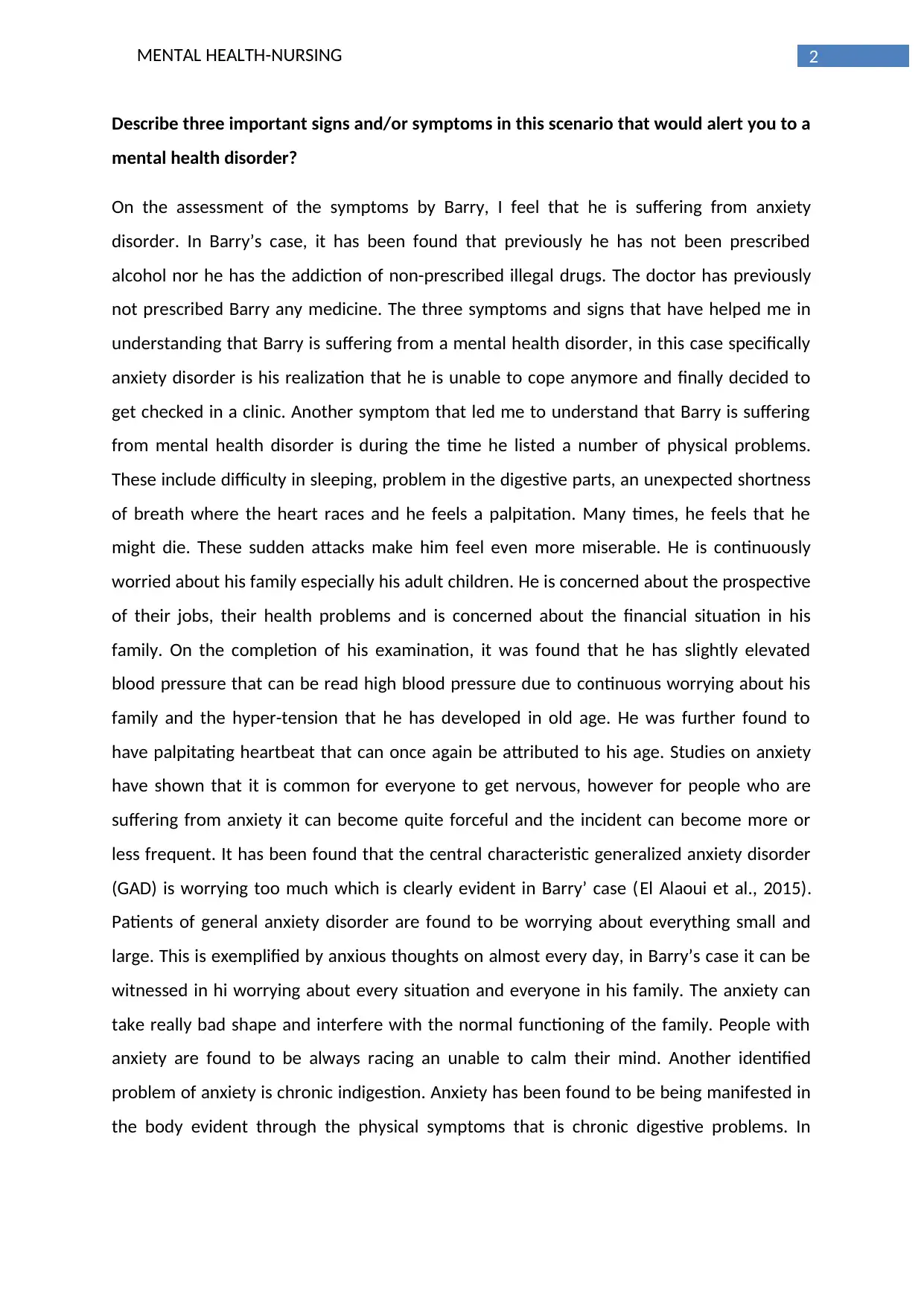
2MENTAL HEALTH-NURSING
Describe three important signs and/or symptoms in this scenario that would alert you to a
mental health disorder?
On the assessment of the symptoms by Barry, I feel that he is suffering from anxiety
disorder. In Barry’s case, it has been found that previously he has not been prescribed
alcohol nor he has the addiction of non-prescribed illegal drugs. The doctor has previously
not prescribed Barry any medicine. The three symptoms and signs that have helped me in
understanding that Barry is suffering from a mental health disorder, in this case specifically
anxiety disorder is his realization that he is unable to cope anymore and finally decided to
get checked in a clinic. Another symptom that led me to understand that Barry is suffering
from mental health disorder is during the time he listed a number of physical problems.
These include difficulty in sleeping, problem in the digestive parts, an unexpected shortness
of breath where the heart races and he feels a palpitation. Many times, he feels that he
might die. These sudden attacks make him feel even more miserable. He is continuously
worried about his family especially his adult children. He is concerned about the prospective
of their jobs, their health problems and is concerned about the financial situation in his
family. On the completion of his examination, it was found that he has slightly elevated
blood pressure that can be read high blood pressure due to continuous worrying about his
family and the hyper-tension that he has developed in old age. He was further found to
have palpitating heartbeat that can once again be attributed to his age. Studies on anxiety
have shown that it is common for everyone to get nervous, however for people who are
suffering from anxiety it can become quite forceful and the incident can become more or
less frequent. It has been found that the central characteristic generalized anxiety disorder
(GAD) is worrying too much which is clearly evident in Barry’ case (El Alaoui et al., 2015).
Patients of general anxiety disorder are found to be worrying about everything small and
large. This is exemplified by anxious thoughts on almost every day, in Barry’s case it can be
witnessed in hi worrying about every situation and everyone in his family. The anxiety can
take really bad shape and interfere with the normal functioning of the family. People with
anxiety are found to be always racing an unable to calm their mind. Another identified
problem of anxiety is chronic indigestion. Anxiety has been found to be being manifested in
the body evident through the physical symptoms that is chronic digestive problems. In
Describe three important signs and/or symptoms in this scenario that would alert you to a
mental health disorder?
On the assessment of the symptoms by Barry, I feel that he is suffering from anxiety
disorder. In Barry’s case, it has been found that previously he has not been prescribed
alcohol nor he has the addiction of non-prescribed illegal drugs. The doctor has previously
not prescribed Barry any medicine. The three symptoms and signs that have helped me in
understanding that Barry is suffering from a mental health disorder, in this case specifically
anxiety disorder is his realization that he is unable to cope anymore and finally decided to
get checked in a clinic. Another symptom that led me to understand that Barry is suffering
from mental health disorder is during the time he listed a number of physical problems.
These include difficulty in sleeping, problem in the digestive parts, an unexpected shortness
of breath where the heart races and he feels a palpitation. Many times, he feels that he
might die. These sudden attacks make him feel even more miserable. He is continuously
worried about his family especially his adult children. He is concerned about the prospective
of their jobs, their health problems and is concerned about the financial situation in his
family. On the completion of his examination, it was found that he has slightly elevated
blood pressure that can be read high blood pressure due to continuous worrying about his
family and the hyper-tension that he has developed in old age. He was further found to
have palpitating heartbeat that can once again be attributed to his age. Studies on anxiety
have shown that it is common for everyone to get nervous, however for people who are
suffering from anxiety it can become quite forceful and the incident can become more or
less frequent. It has been found that the central characteristic generalized anxiety disorder
(GAD) is worrying too much which is clearly evident in Barry’ case (El Alaoui et al., 2015).
Patients of general anxiety disorder are found to be worrying about everything small and
large. This is exemplified by anxious thoughts on almost every day, in Barry’s case it can be
witnessed in hi worrying about every situation and everyone in his family. The anxiety can
take really bad shape and interfere with the normal functioning of the family. People with
anxiety are found to be always racing an unable to calm their mind. Another identified
problem of anxiety is chronic indigestion. Anxiety has been found to be being manifested in
the body evident through the physical symptoms that is chronic digestive problems. In
⊘ This is a preview!⊘
Do you want full access?
Subscribe today to unlock all pages.

Trusted by 1+ million students worldwide
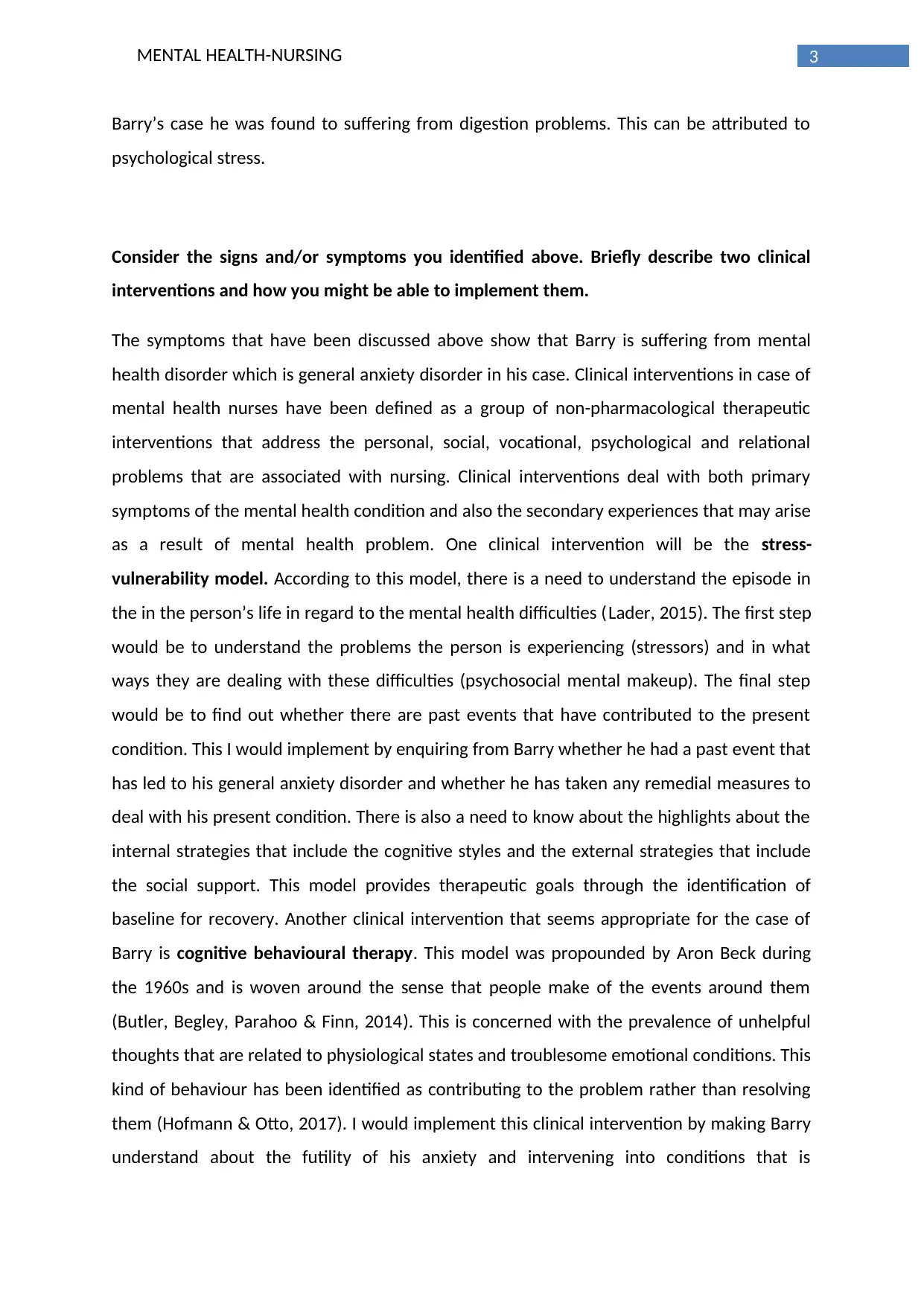
3MENTAL HEALTH-NURSING
Barry’s case he was found to suffering from digestion problems. This can be attributed to
psychological stress.
Consider the signs and/or symptoms you identified above. Briefly describe two clinical
interventions and how you might be able to implement them.
The symptoms that have been discussed above show that Barry is suffering from mental
health disorder which is general anxiety disorder in his case. Clinical interventions in case of
mental health nurses have been defined as a group of non-pharmacological therapeutic
interventions that address the personal, social, vocational, psychological and relational
problems that are associated with nursing. Clinical interventions deal with both primary
symptoms of the mental health condition and also the secondary experiences that may arise
as a result of mental health problem. One clinical intervention will be the stress-
vulnerability model. According to this model, there is a need to understand the episode in
the in the person’s life in regard to the mental health difficulties (Lader, 2015). The first step
would be to understand the problems the person is experiencing (stressors) and in what
ways they are dealing with these difficulties (psychosocial mental makeup). The final step
would be to find out whether there are past events that have contributed to the present
condition. This I would implement by enquiring from Barry whether he had a past event that
has led to his general anxiety disorder and whether he has taken any remedial measures to
deal with his present condition. There is also a need to know about the highlights about the
internal strategies that include the cognitive styles and the external strategies that include
the social support. This model provides therapeutic goals through the identification of
baseline for recovery. Another clinical intervention that seems appropriate for the case of
Barry is cognitive behavioural therapy. This model was propounded by Aron Beck during
the 1960s and is woven around the sense that people make of the events around them
(Butler, Begley, Parahoo & Finn, 2014). This is concerned with the prevalence of unhelpful
thoughts that are related to physiological states and troublesome emotional conditions. This
kind of behaviour has been identified as contributing to the problem rather than resolving
them (Hofmann & Otto, 2017). I would implement this clinical intervention by making Barry
understand about the futility of his anxiety and intervening into conditions that is
Barry’s case he was found to suffering from digestion problems. This can be attributed to
psychological stress.
Consider the signs and/or symptoms you identified above. Briefly describe two clinical
interventions and how you might be able to implement them.
The symptoms that have been discussed above show that Barry is suffering from mental
health disorder which is general anxiety disorder in his case. Clinical interventions in case of
mental health nurses have been defined as a group of non-pharmacological therapeutic
interventions that address the personal, social, vocational, psychological and relational
problems that are associated with nursing. Clinical interventions deal with both primary
symptoms of the mental health condition and also the secondary experiences that may arise
as a result of mental health problem. One clinical intervention will be the stress-
vulnerability model. According to this model, there is a need to understand the episode in
the in the person’s life in regard to the mental health difficulties (Lader, 2015). The first step
would be to understand the problems the person is experiencing (stressors) and in what
ways they are dealing with these difficulties (psychosocial mental makeup). The final step
would be to find out whether there are past events that have contributed to the present
condition. This I would implement by enquiring from Barry whether he had a past event that
has led to his general anxiety disorder and whether he has taken any remedial measures to
deal with his present condition. There is also a need to know about the highlights about the
internal strategies that include the cognitive styles and the external strategies that include
the social support. This model provides therapeutic goals through the identification of
baseline for recovery. Another clinical intervention that seems appropriate for the case of
Barry is cognitive behavioural therapy. This model was propounded by Aron Beck during
the 1960s and is woven around the sense that people make of the events around them
(Butler, Begley, Parahoo & Finn, 2014). This is concerned with the prevalence of unhelpful
thoughts that are related to physiological states and troublesome emotional conditions. This
kind of behaviour has been identified as contributing to the problem rather than resolving
them (Hofmann & Otto, 2017). I would implement this clinical intervention by making Barry
understand about the futility of his anxiety and intervening into conditions that is
Paraphrase This Document
Need a fresh take? Get an instant paraphrase of this document with our AI Paraphraser
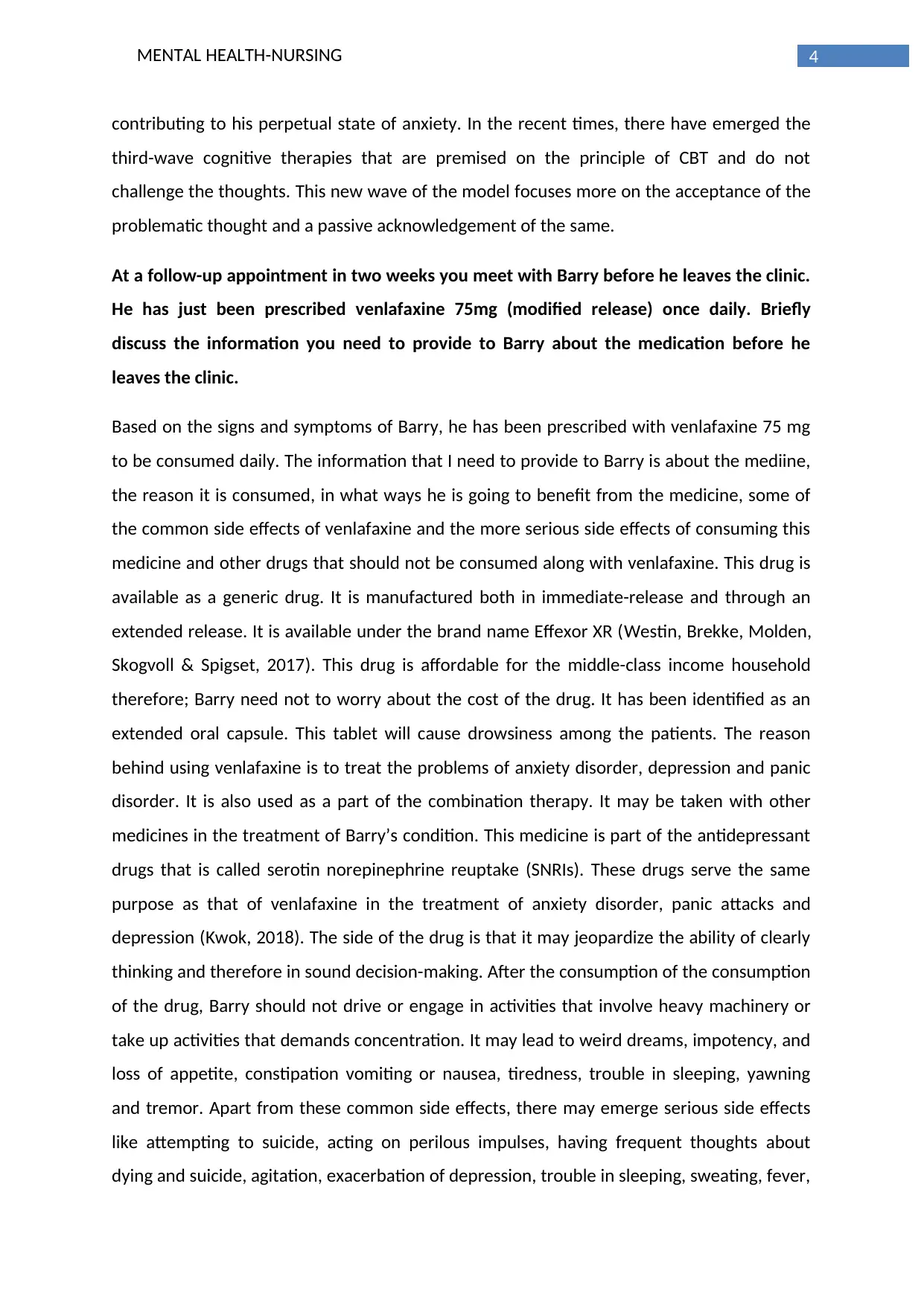
4MENTAL HEALTH-NURSING
contributing to his perpetual state of anxiety. In the recent times, there have emerged the
third-wave cognitive therapies that are premised on the principle of CBT and do not
challenge the thoughts. This new wave of the model focuses more on the acceptance of the
problematic thought and a passive acknowledgement of the same.
At a follow-up appointment in two weeks you meet with Barry before he leaves the clinic.
He has just been prescribed venlafaxine 75mg (modified release) once daily. Briefly
discuss the information you need to provide to Barry about the medication before he
leaves the clinic.
Based on the signs and symptoms of Barry, he has been prescribed with venlafaxine 75 mg
to be consumed daily. The information that I need to provide to Barry is about the mediine,
the reason it is consumed, in what ways he is going to benefit from the medicine, some of
the common side effects of venlafaxine and the more serious side effects of consuming this
medicine and other drugs that should not be consumed along with venlafaxine. This drug is
available as a generic drug. It is manufactured both in immediate-release and through an
extended release. It is available under the brand name Effexor XR (Westin, Brekke, Molden,
Skogvoll & Spigset, 2017). This drug is affordable for the middle-class income household
therefore; Barry need not to worry about the cost of the drug. It has been identified as an
extended oral capsule. This tablet will cause drowsiness among the patients. The reason
behind using venlafaxine is to treat the problems of anxiety disorder, depression and panic
disorder. It is also used as a part of the combination therapy. It may be taken with other
medicines in the treatment of Barry’s condition. This medicine is part of the antidepressant
drugs that is called serotin norepinephrine reuptake (SNRIs). These drugs serve the same
purpose as that of venlafaxine in the treatment of anxiety disorder, panic attacks and
depression (Kwok, 2018). The side of the drug is that it may jeopardize the ability of clearly
thinking and therefore in sound decision-making. After the consumption of the consumption
of the drug, Barry should not drive or engage in activities that involve heavy machinery or
take up activities that demands concentration. It may lead to weird dreams, impotency, and
loss of appetite, constipation vomiting or nausea, tiredness, trouble in sleeping, yawning
and tremor. Apart from these common side effects, there may emerge serious side effects
like attempting to suicide, acting on perilous impulses, having frequent thoughts about
dying and suicide, agitation, exacerbation of depression, trouble in sleeping, sweating, fever,
contributing to his perpetual state of anxiety. In the recent times, there have emerged the
third-wave cognitive therapies that are premised on the principle of CBT and do not
challenge the thoughts. This new wave of the model focuses more on the acceptance of the
problematic thought and a passive acknowledgement of the same.
At a follow-up appointment in two weeks you meet with Barry before he leaves the clinic.
He has just been prescribed venlafaxine 75mg (modified release) once daily. Briefly
discuss the information you need to provide to Barry about the medication before he
leaves the clinic.
Based on the signs and symptoms of Barry, he has been prescribed with venlafaxine 75 mg
to be consumed daily. The information that I need to provide to Barry is about the mediine,
the reason it is consumed, in what ways he is going to benefit from the medicine, some of
the common side effects of venlafaxine and the more serious side effects of consuming this
medicine and other drugs that should not be consumed along with venlafaxine. This drug is
available as a generic drug. It is manufactured both in immediate-release and through an
extended release. It is available under the brand name Effexor XR (Westin, Brekke, Molden,
Skogvoll & Spigset, 2017). This drug is affordable for the middle-class income household
therefore; Barry need not to worry about the cost of the drug. It has been identified as an
extended oral capsule. This tablet will cause drowsiness among the patients. The reason
behind using venlafaxine is to treat the problems of anxiety disorder, depression and panic
disorder. It is also used as a part of the combination therapy. It may be taken with other
medicines in the treatment of Barry’s condition. This medicine is part of the antidepressant
drugs that is called serotin norepinephrine reuptake (SNRIs). These drugs serve the same
purpose as that of venlafaxine in the treatment of anxiety disorder, panic attacks and
depression (Kwok, 2018). The side of the drug is that it may jeopardize the ability of clearly
thinking and therefore in sound decision-making. After the consumption of the consumption
of the drug, Barry should not drive or engage in activities that involve heavy machinery or
take up activities that demands concentration. It may lead to weird dreams, impotency, and
loss of appetite, constipation vomiting or nausea, tiredness, trouble in sleeping, yawning
and tremor. Apart from these common side effects, there may emerge serious side effects
like attempting to suicide, acting on perilous impulses, having frequent thoughts about
dying and suicide, agitation, exacerbation of depression, trouble in sleeping, sweating, fever,
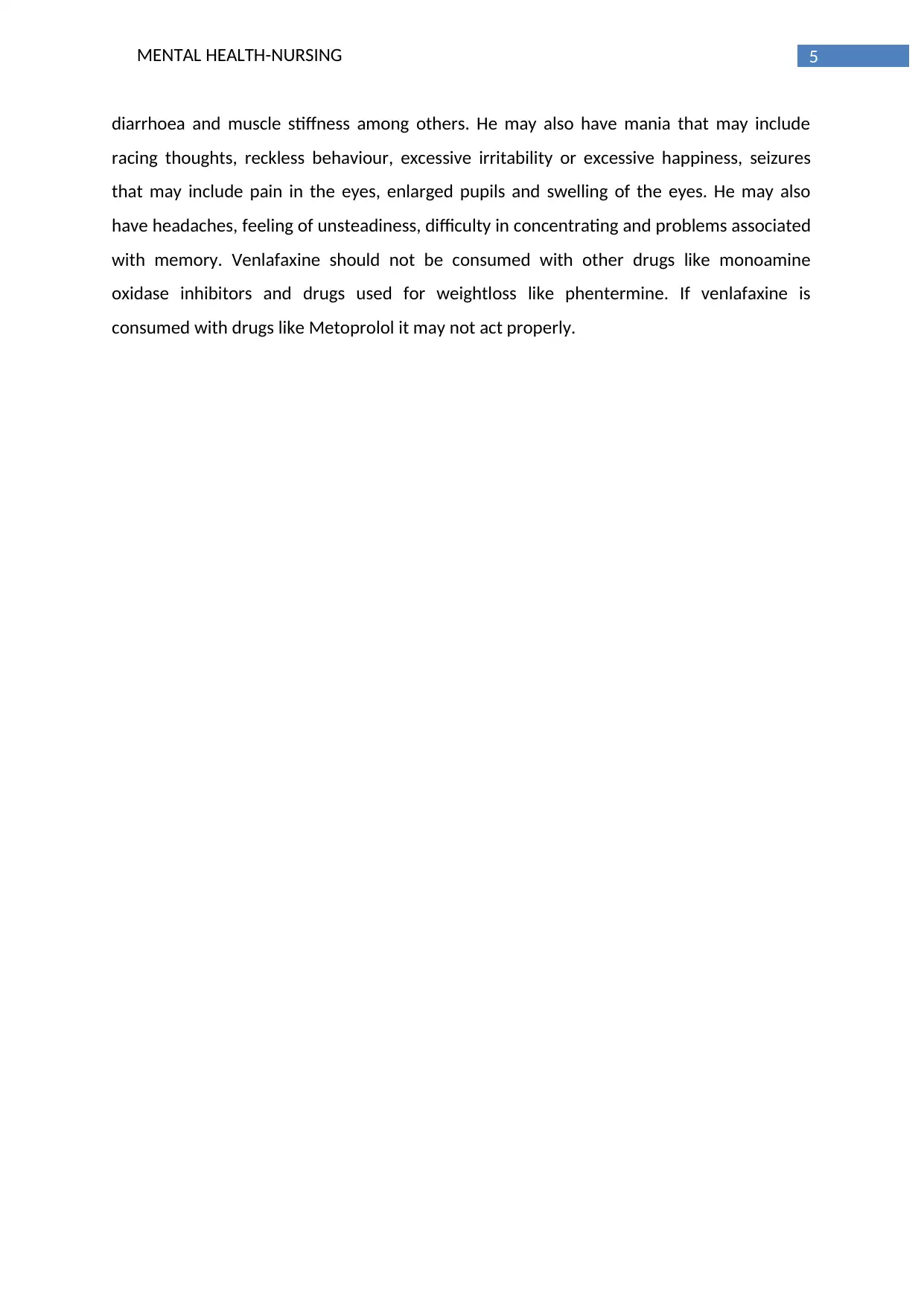
5MENTAL HEALTH-NURSING
diarrhoea and muscle stiffness among others. He may also have mania that may include
racing thoughts, reckless behaviour, excessive irritability or excessive happiness, seizures
that may include pain in the eyes, enlarged pupils and swelling of the eyes. He may also
have headaches, feeling of unsteadiness, difficulty in concentrating and problems associated
with memory. Venlafaxine should not be consumed with other drugs like monoamine
oxidase inhibitors and drugs used for weightloss like phentermine. If venlafaxine is
consumed with drugs like Metoprolol it may not act properly.
diarrhoea and muscle stiffness among others. He may also have mania that may include
racing thoughts, reckless behaviour, excessive irritability or excessive happiness, seizures
that may include pain in the eyes, enlarged pupils and swelling of the eyes. He may also
have headaches, feeling of unsteadiness, difficulty in concentrating and problems associated
with memory. Venlafaxine should not be consumed with other drugs like monoamine
oxidase inhibitors and drugs used for weightloss like phentermine. If venlafaxine is
consumed with drugs like Metoprolol it may not act properly.
⊘ This is a preview!⊘
Do you want full access?
Subscribe today to unlock all pages.

Trusted by 1+ million students worldwide
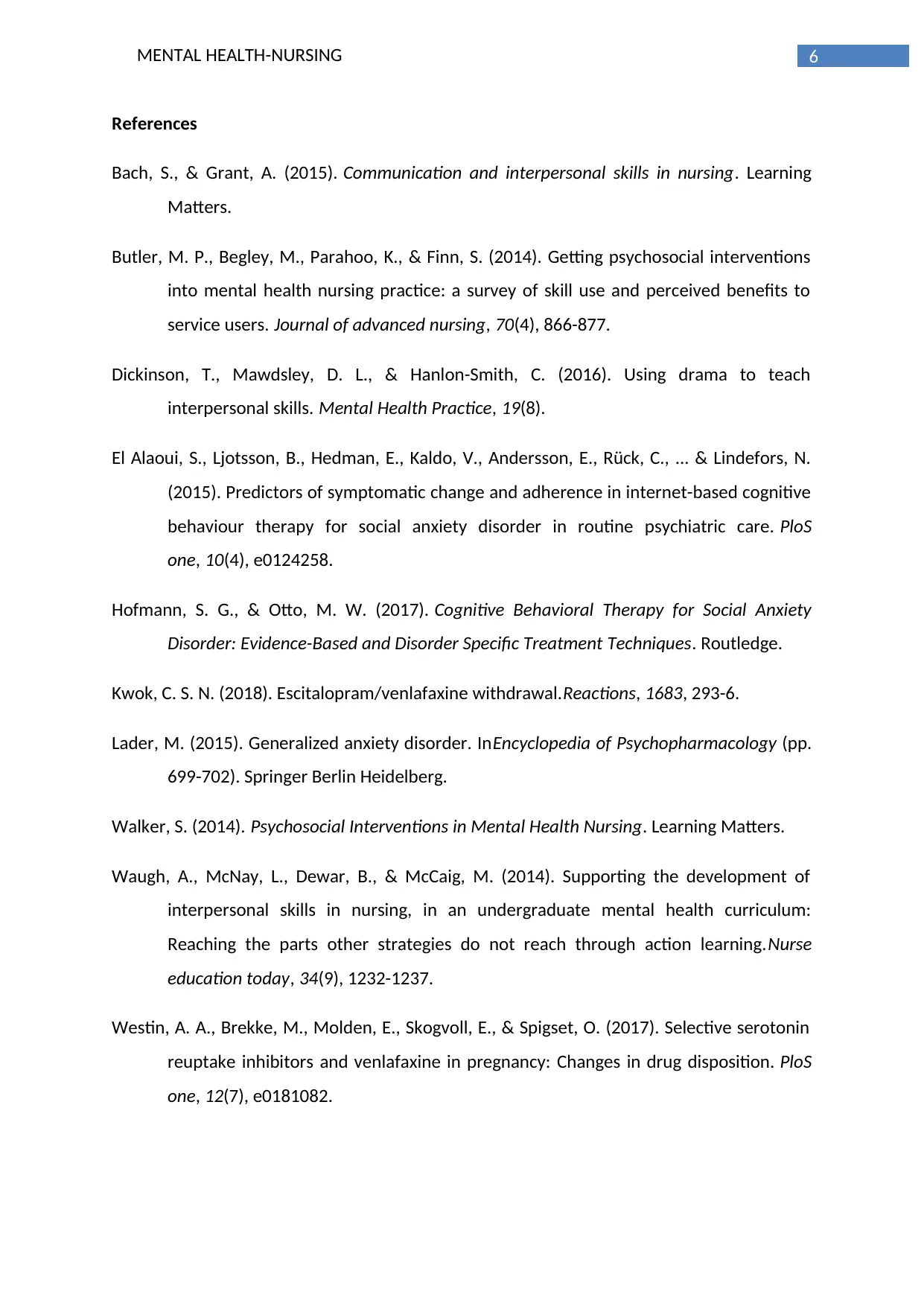
6MENTAL HEALTH-NURSING
References
Bach, S., & Grant, A. (2015). Communication and interpersonal skills in nursing. Learning
Matters.
Butler, M. P., Begley, M., Parahoo, K., & Finn, S. (2014). Getting psychosocial interventions
into mental health nursing practice: a survey of skill use and perceived benefits to
service users. Journal of advanced nursing, 70(4), 866-877.
Dickinson, T., Mawdsley, D. L., & Hanlon-Smith, C. (2016). Using drama to teach
interpersonal skills. Mental Health Practice, 19(8).
El Alaoui, S., Ljotsson, B., Hedman, E., Kaldo, V., Andersson, E., Rück, C., ... & Lindefors, N.
(2015). Predictors of symptomatic change and adherence in internet-based cognitive
behaviour therapy for social anxiety disorder in routine psychiatric care. PloS
one, 10(4), e0124258.
Hofmann, S. G., & Otto, M. W. (2017). Cognitive Behavioral Therapy for Social Anxiety
Disorder: Evidence-Based and Disorder Specific Treatment Techniques. Routledge.
Kwok, C. S. N. (2018). Escitalopram/venlafaxine withdrawal.Reactions, 1683, 293-6.
Lader, M. (2015). Generalized anxiety disorder. InEncyclopedia of Psychopharmacology (pp.
699-702). Springer Berlin Heidelberg.
Walker, S. (2014). Psychosocial Interventions in Mental Health Nursing. Learning Matters.
Waugh, A., McNay, L., Dewar, B., & McCaig, M. (2014). Supporting the development of
interpersonal skills in nursing, in an undergraduate mental health curriculum:
Reaching the parts other strategies do not reach through action learning.Nurse
education today, 34(9), 1232-1237.
Westin, A. A., Brekke, M., Molden, E., Skogvoll, E., & Spigset, O. (2017). Selective serotonin
reuptake inhibitors and venlafaxine in pregnancy: Changes in drug disposition. PloS
one, 12(7), e0181082.
References
Bach, S., & Grant, A. (2015). Communication and interpersonal skills in nursing. Learning
Matters.
Butler, M. P., Begley, M., Parahoo, K., & Finn, S. (2014). Getting psychosocial interventions
into mental health nursing practice: a survey of skill use and perceived benefits to
service users. Journal of advanced nursing, 70(4), 866-877.
Dickinson, T., Mawdsley, D. L., & Hanlon-Smith, C. (2016). Using drama to teach
interpersonal skills. Mental Health Practice, 19(8).
El Alaoui, S., Ljotsson, B., Hedman, E., Kaldo, V., Andersson, E., Rück, C., ... & Lindefors, N.
(2015). Predictors of symptomatic change and adherence in internet-based cognitive
behaviour therapy for social anxiety disorder in routine psychiatric care. PloS
one, 10(4), e0124258.
Hofmann, S. G., & Otto, M. W. (2017). Cognitive Behavioral Therapy for Social Anxiety
Disorder: Evidence-Based and Disorder Specific Treatment Techniques. Routledge.
Kwok, C. S. N. (2018). Escitalopram/venlafaxine withdrawal.Reactions, 1683, 293-6.
Lader, M. (2015). Generalized anxiety disorder. InEncyclopedia of Psychopharmacology (pp.
699-702). Springer Berlin Heidelberg.
Walker, S. (2014). Psychosocial Interventions in Mental Health Nursing. Learning Matters.
Waugh, A., McNay, L., Dewar, B., & McCaig, M. (2014). Supporting the development of
interpersonal skills in nursing, in an undergraduate mental health curriculum:
Reaching the parts other strategies do not reach through action learning.Nurse
education today, 34(9), 1232-1237.
Westin, A. A., Brekke, M., Molden, E., Skogvoll, E., & Spigset, O. (2017). Selective serotonin
reuptake inhibitors and venlafaxine in pregnancy: Changes in drug disposition. PloS
one, 12(7), e0181082.
1 out of 7
Related Documents
Your All-in-One AI-Powered Toolkit for Academic Success.
+13062052269
info@desklib.com
Available 24*7 on WhatsApp / Email
![[object Object]](/_next/static/media/star-bottom.7253800d.svg)
Unlock your academic potential
Copyright © 2020–2025 A2Z Services. All Rights Reserved. Developed and managed by ZUCOL.




